
Consuming a health promoting blend of protein, fats, and carbohydrates at regular meals throughout the day has a wealth of benefits – including keeping you comfortably satisfied until your next meal. And keeping things as simple as possible here is very important.
It stands to be true that long term we all have trouble staying consistent with complex habits. Yes, research demonstrated the more complicated and/or time consuming the habit is the less likely it is to stick around. And the most important aspect of a healthy lifestyle change – be it targeting fat loss, improved energy levels, boosted performance, or otherwise – is adherence. Simply stated, you can’t achieve results if you aren’t consistent with your approach. We could include references here, but do not feel it’s necessary to prove this widely experienced point…
To help with the simplicity, we recommend keeping this basic formula in mind as you plan your plate: half (50%) vegetables & fruit, one quarter (25%) lean protein, one quarter (25%) carbohydrates, and a sprinkle of healthy fats (mainly for cooking and flavouring the meal).
Now if you end up having pizza or a burger for dinner one night, please do not worry about it. All is certainly not lost – so long as you respond appropriately. Simply turn back to these ratios as best you can on your next meal. It is what we do most of the time that really matters – with so many things in life – but especially nutrition.
Getting more specific, we recommend keeping in mind the guidelines below to set the stage for success and follow a balanced and health promoting diet each day:
Load up with a Base of Vegetables and Fruit

They take up more space in your stomach for fewer calories than other foods, triggering receptors that tell your brain you’re full. Plus they’re packed with disease fighting phytonutrients and heart-healthy fibre. We recommend you aim to consume at least two types of vegetables to make up 50% of your plate, or a vegetable plus a fruit. If you’re having a starchy vegetable (such as yams, corn, or squash), consider this part of the carbohydrate category.
Pick a Protein
Protein very effectively lowers levels of the hunger hormone ghrelin – and leaner choices are recommended to keep fat and overall calories in check. Go for poultry, fish, low-fat dairy (full fat cheese should be considered a fat), eggs, legumes, and soy-based tofu or tempeh.
Figure out Carbohydrates

Refined carbs – like white bread and white rice – cause a dramatic rise and subsequent fall in blood sugar. Complex carbs, on the other hand, contain more fibre which is absorbed slowly, providing steady energy. Top examples in this recommended complex carb category include whole grain bread and pasta, brown rice, and beans. To learn more about the important topic of blood sugar control, we recommend you review our blog on the topic.
Finish With a Little Fat
To reap the most health benefit, stick with heart-heath supporting unsaturated fat as much as possible – think vegetable oil, avocado, and nuts & seeds.
Today we are being hit with more information than ever before. And especially in the area of food and nutrition, so much of it tends to be conflicting – making something that could be thought of quite simply unnecessarily confusing. Cue the overwhelming feeling tempting you to give up entirely… We get it.

But the truth is, getting good nutrition each day does not need to be complicated. You can – and most definitely should – enjoy the foods you love at all times of year. Indeed, eating healthy doesn’t have to be fancy, but it does have to taste good and be enjoyable to do routinely for a long period of time. There is no secret to diet success, but if there was one consistency over time would be it.
Even if you’re on a tight budget, healthy eating can still be possible. To help you stay mindful on this front we recommend you review our resource for shopping and kitchen tips to keep your wallet in check as you progress towards your physical goals.
Happy shopping – and eating – into 2020 friends.



